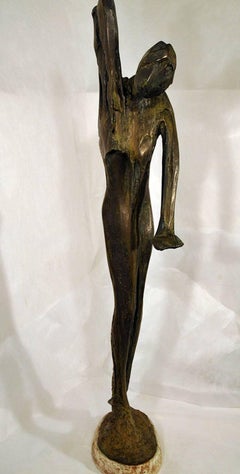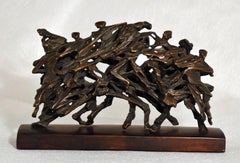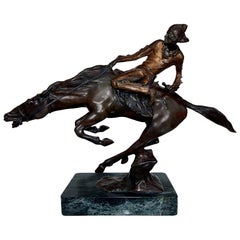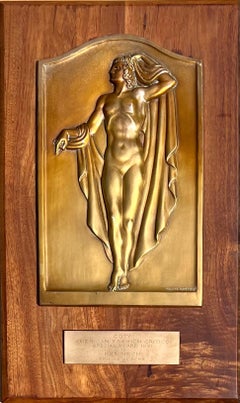The Old Print Shop, Inc. Sculptures
to
1
1
Overall Width
to
Overall Height
to
2
1
2
2
2
2
2
1
1
2
2
1
1
2
2
Up
By Robert Cook
Located in New York, NY
Bronze, 1967. Height 59" (149.9 cm) width max 15" (38 cm).
Signed on base "R Cook." This unique large sculpture was made using the lost wax process.
“ ...
Category
Mid-20th Century American Modern Figurative Sculptures
Materials
Stone, Bronze
$35,000
Harlem III
By Robert Cook
Located in New York, NY
Signed, titled, and dated in ink on base verso. Unique sculpture created using the lost wax process. This piece is 7 1/2" high x 12" wide x 3 1/2" deep.
Robert Cook was born in Boston in 1921. He studied with George Demetrios...
Category
1990s Modern Figurative Sculptures
Materials
Bronze
Related Items
Bruno Zach Deco Bronze Sculpture, 1925, Native American Subject
By Bruno Zach
Located in Phoenix, AZ
Beautifully cast deco Austrian bronze titled: “Indian Brave on Charging Horse.”
Sitz on a marble plinth. The figure has a cold painted buckskin colored shirt and pant.
Signed on base...
Category
Early 20th Century Modern Figurative Sculptures
Materials
Bronze
$9,000
H 14.5 in W 19.5 in D 4.5 in
1961 Coty Award Plaque Kenneth Hairdresser Jacqueline Onassis Bronze Fashion
Located in New York, NY
1961 Coty Award Plaque Kenneth Hairdresser Jacqueline Onassis Bronze Fashion
Bronze on wood. The wood plaque measures 12 3/4" by 20 3/4 inches. The bronze plaque itself is 13 3/4 x 8 3/4 inches and the the bronze inscription, which reads "COTY, American Fashion Critics Special Award 1961 to KENNETH of LILY DACHE...
Category
1960s American Modern Figurative Sculptures
Materials
Bronze
Woman Seated A Bronze Sculpture of a Woman by Charles Rumsey
By Charles Cary Rumsey
Located in Brookville, NY
The bronze sculpture of a woman by Charles Rumsey is undated, but was created at a point in his career where he began to transition from realism to more modern, looser depictions of ...
Category
1920s American Modern Figurative Sculptures
Materials
Bronze
$6,000
H 10.5 in W 11 in D 6 in
Bronze Abstract Space Age Book Sculpture LA California Modernist Charna Rickey
By Charna Rickey
Located in Surfside, FL
Charna Rickey 1923 - 2000 Mexican-American Jewish Woman artist.
Signed Bronze House of Books, Architecture Bronze sculpture, signed Charna Rickey and on the front "House of the book." It depicts an open Torah. Original patina.
Approx. dimensions: 7 in. H x 9 in. W x 8.5 in. D. Weight: 13.1 lbs.
Modernist Judaica Sculpture
Born Charna Barsky (Charna Ysabel or Isabel Rickey Barsky) in Chihuahua, Mexico, the future artist lived in Hermosillo and immigrated to Los Angeles when she was 11. She was educated at UCLA and Cal State L.A., she married furniture retailer David Rickey and explored art while raising their three daughters. Moving through phases in terra cotta, bronze, marble and aluminum, she found success later in life. Rickey became one of the original art teachers at Everywoman's Village, a pioneering learning center for women established by three housewives in Van Nuys in 1963. She also taught sculpture at the University of Judaism from 1965 to 1981.
As Rickey became more successful, her sculptures were exhibited in such venues as Artspace Gallery in Woodland Hills and the Courtyard of Century Plaza Towers as part of a 1989 Sculpture Walk produced by the Los Angeles Arts Council. Her sculptures have also found their way into the private collections of such celebrities as Sharon Stone.
Another of Rickey's international creations originally stood at Santa Monica College. In 1985, her 12-foot-high musical sculpture shaped like the Hebrew letter "shin" was moved to the Rubin Academy of Music and Dance at Hebrew University in Jerusalem. The free standing architectural Judaic aluminum work has strings that vibrate in the wind to produce sounds. Rickey also created art pieces for the city of Brea. They commissioned some amazing art pieces by Laddie John Dill, Walter Dusenbery, Woods Davy, Rod Kagan, Pol Bury, Niki de Saint Phalle, Magdalena Abakanowicz, Larry Bell, John Okulick...
Category
20th Century American Modern Abstract Sculptures
Materials
Marble, Bronze
$2,200
H 7 in W 9 in D 8.5 in
La Source (The Stream)
Located in Greenwich, CT
A superb smaller version of a large scale commission work that stands in Bordeaux at the Hotel Fruges! Lovely patina - a lighter but rich and warm brown tone that is rare to see in ...
Category
1920s Modern Figurative Sculptures
Materials
Bronze
Horse with Rider Looking at the Stars
Located in Greenwich, CT
Juárez, a renowned self-taught Mexican sculptor, displays his expressive depiction of animals and humans in our Caballo con Jinete Viendo las Estrellas (Horse with Rider Seeing the S...
Category
1970s Modern Figurative Sculptures
Materials
Bronze
Large Gilt Bronze Sculptures of Cheetahs
Located in Rome, IT
Fantastic pair of gilt bronze Cheetahs sculptures . The item will be well-suited to either an indoor or outdoor setting.
Category
Early 2000s Modern Figurative Sculptures
Materials
Bronze
Untitled Portrait Head (perhaps Arnold Geissbuhler, the artist’s husband)
Located in Los Angeles, CA
Untitled Portrait Head (perhaps Arnold Geissbuhler, the artist’s husband), c. 1920s, bronze, signed verso, 11 x 9 x 7 inches (excluding base)
Elizabeth Chase was a sculptor, printma...
Category
1920s American Modern Figurative Sculptures
Materials
Bronze
$2,500
H 11 in W 9 in D 7 in
Joie De Vivre, bronze figurative dance sculpture
Located in Greenwich, CT
This joyous in the round bronze can turn on its base, making for dramatic presentation and enjoyment that is interactive. It is based on the idea of the Three Graces which is often an allegorical subject in sculpture. Wein has done a contemporary feeling interpretation of this classic theme. Piece itself measure 12 1/2 inches and sits on a 3 1/4 inch base and is attached to its base at two points and it is a revolving or rather turning base. The two points on which the toes touch and are secured are striking for how little of the bronze touches the base. It is Fourth in an edition of 13. Albert Wein...
Category
Mid-20th Century American Modern Figurative Sculptures
Materials
Bronze
"Naomi" Mid 20th Century American Bronze Sculpture Female Portrait Figurative
Located in New York, NY
"Naomi" Mid 20th Century American Bronze Sculpture Female Portrait Figurative
Albert W. Wein (1915-1991)
"Naomi"
Bronze, c. 1960s
Signed
Figure: 19 1/2 x 5 1/2 x 5 inches
Overall he...
Category
1960s American Modern Figurative Sculptures
Materials
Bronze
$15,000
H 23 in W 5 in D 5 in
Mark Kostabi - Divine Embrace - Bronze Sculpture
By Mark Kostabi
Located in Winterswijk, NL
Mark Kostabi - Divine Embrace - Bronze sculpture
Divine Embrace is a unique bronze sculpture by renowned artist Mark Kostabi, featuring two faceless figures in an intimate embrace...
Category
21st Century and Contemporary American Modern Figurative Sculptures
Materials
Bronze
Harmony, 20th century bronze & green marble base, nude man and woman with lyre
By Max Kalish
Located in Beachwood, OH
Max Kalish (American, 1891-1945)
Harmony, c. 1930
Bronze with green marble base
Incised signature on right upper side of base
14 x 9 x 5 inches, excluding base
17 x 10 x 8 inches, including base
Born in Poland March 1, 1891, figurative sculptor Max Kalish came to the United States in 1894, his family settling in Ohio. A talented youth, Kalish enrolled at the Cleveland Institute of Art as a fifteen-year-old, receiving a first-place award for modeling the figure during studies with Herman Matzen. Kalish went to New York City following graduation, studying with Isidore Konti...
Category
1930s American Modern Figurative Sculptures
Materials
Marble, Bronze
$10,450
H 17 in W 10 in D 8 in



